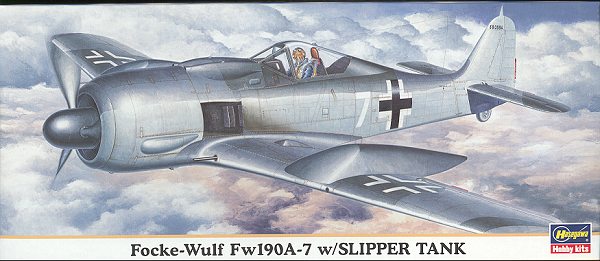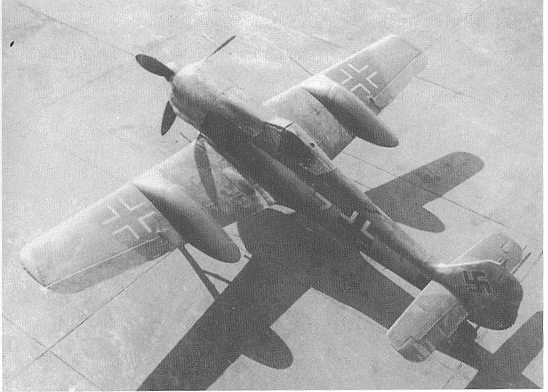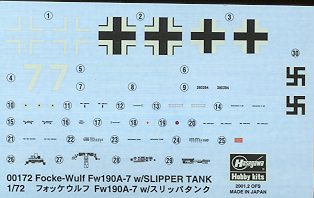
|
KIT: |
Hasegawa 1/72 FW-190A-7 |
|
KIT # |
00172 |
|
PRICE: |
$19.00 (?) |
|
DECALS: |
One aircraft |
|
REVIEW & |
|
|
NOTES: |
Resin fuel tanks included` |

|
HISTORY |

Really, this is more about the unique 'slipper' overwing fuel tanks than it is about the FW-190A. You can find more FW-190 stuff on the web than you can shake a stick at, but the slipper tanks are another story. The entire design was an attempt to find something that would create less drag than a standard centerline drop tank. It was also something that was developed in conjunction with the Mistel 3 program. For those of you unfamiliar with the Mistel, it was a project that piggybacked a fighter atop a war weary bomber whose crew compartment had been replaced with a shaped charge of several tons of explosive.
This combination was controlled from the upper aircraft and was designed to be used against heavily fortified structures, initially warships. The program was only mildly successful as there was a lot of difficulty in properly aiming the lower bomber/bomb combination. The first Mistel was with a Bf-109F upper component and a Ju-88A-4 lower. Mistel 2 was an Fw-190A-8 and Ju-88G-1 combination. This was chosen because both used the same octane fuel and the 190 could transfer fuel needed from the Ju-88G.
Mistel 3 was the final production version. It also used a FW-190 upper component, but used the stretched Ju-88G-10. No armed Mistel3s were produced but several trainers were completed before the war was finished. One of the various Mistel 3 proposals was for a 'Fuhrungsmaschine' or ultra long range recce version. This would carry the FW-190A upper component as fighter protection. All of the Mistel 3s were to be long range missions. As such the FW-190 would need extra fuel to enable it to return. Thus the 270 liter 'Doppelreiter' over wing fuel tanks were developed.
An Fw-190A-8 and Fw-190G-1 were used in developing these fuel tanks during flight tests in July/August 1944. It was discovered that the regular centerline drop tank resulted in a loss of speed of 33 kph. The overwing tanks reduced that to 13 kph. Fw-190A 'White 7' was fitted with these tanks and delivered to Rechlin for more testing in conjunction with the Mistel projects. However, it was found that when these tanks were empty, it caused a shift in the balance of the plane. This caused 'snaking' in the vertical axis and made landings hazardous. It was found that removing the aft fuel tank resolved this problem, but that negated the benefit of the Doppelreiter tanks.
|
THE KIT |

What you have here is your standard Hasegawa Fw-190 kit with the extra resin bits for the over wing fuel tanks. To give a brief rundown on the model, you have decals for instruments, engraved panel lines, a two-piece canopy, and two separate upper engine cowls; one for an A-5 and the other for an A-8. A nice touch is that the upper wings have areas for you to open holes that match the stubs molded into the bottom of the slipper tanks. I wouldn't fair in these tanks with putty as they were designed to be removable.
 The box art and
the instructions call it an FW-190A-7. OK, I'll go for that, at least until a
190 fanatic tells me that it is different. Having seen a number of Hase 1/72
190s at shows, I can tell you it is a beauty. Instructions are typically super
as one expects from Hasegawa. The decal sheet is small, but since it is just for
one particular FW-190, it is appropriate. It is nice to see a swastika in the
sheet as that means you won't have to search around your spare decal bin for
them.
The box art and
the instructions call it an FW-190A-7. OK, I'll go for that, at least until a
190 fanatic tells me that it is different. Having seen a number of Hase 1/72
190s at shows, I can tell you it is a beauty. Instructions are typically super
as one expects from Hasegawa. The decal sheet is small, but since it is just for
one particular FW-190, it is appropriate. It is nice to see a swastika in the
sheet as that means you won't have to search around your spare decal bin for
them.
One thing I did notice regarding this kit and the photograph is that the upper nose cannon are faired over. The only armament this plane carried were the inner wing guns. When used in the Mistel 3 configuration, it would only have had those guns as saving weight was more important than firepower. Another difference from the kit is that it appears that the tail section is mottled. It is hard to tell about the side of the fuselage as it is pretty well coated with engine soot. None of the photos I found of this plane were lit from the side, all had head-on lighting.
Anyway, this looks like a pretty interesting plane to do, especially if you are planning to do a Mistel 3 sometime down the road!
|
REFERENCES |
Mistel: German Composite Aircraft and Operations 1942-1945, by Robert Forsyth, Classic Publications, 2001
Review kit courtesy of me and my wallet!
If you would like your product reviewed fairly and quickly by a site that averages thousands of visits a day, please contact me or see other details in the Note to Contributors.